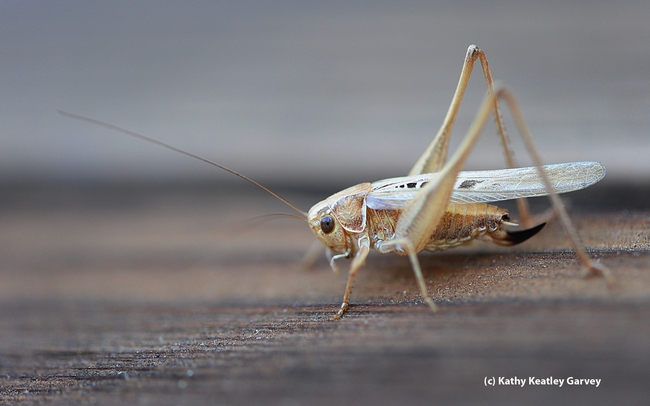- Author: Kathy Keatley Garvey

Mark your calendars for the eagerly awaited open houses and special events at the Bohart Museum of Entomology.
The Bohart has announced its 2024 special events, which include three open houses and participation in the 13th annual UC Davis Biodiversity Museum Day, and 110th annual UC Davis Picnic Day. All are free and family friendly.
The schedule:
Saturday, Jan. 20:
"Social Wasps," 1 to 4 p.m., featuring UC Davis distinguished professor Lynn Kimsey, director of the Bohart Museum. She recently received the 2023 Exceptional Faculty Award from the College of Agricultural and Environmental Sciences. Kimsey, a recognized authority on insect biodiversity, systematics and biogeography of parasitic wasps, urban entomology, civil forensic entomology, and arthropod-related industrial hygiene, is a 34-year member of the UC Davis entomology faculty. She has directed the Bohart Museum since 1990. She plans to retire in 2024. (See news story)
Saturday, Feb. 10:
13th Annual Biodiversity Museum Day, all day. Last year 13 UC Davis museums or collections participated: Arboretum and Public Garden, Bohart Museum of Entomology, Botanical Conservatory. California Raptor Center. Center for Plant Diversity, Department of Anthropology Museum, Marine Invertebrate Collection, Museum of Wildlife and Fish Biology, Nematode Collection, Department of Earth and Planetary Sciences Paleontology Collection, and Phaff Yeast Culture Collection.
Sunday, March 3:
"Grasshoppers, Crickets and Katydids." Talk and a question-and-answer forum from 1 to 2 p.m. Open museum, 2 to 4 p.m. Heading the event is UC Davis undergraduate student Sol Wantz, a senior majoring in entomology and a member o the lab of community ecologist and professor Neal Williams. She serve as president of the UC Davis Entomology Club.
Saturday, April 20:
110th UC Davis Picnic Day, all day. This is billed as the largest student-run event in the country. It is UC Davis' annual open house with hundreds of free and family friendly events. Entomology displays, exhibits and activities planned by the Department of Entomology and Nematology will be at the Bohart Museum and at Briggs Hall.
Sunday, May 19:
"Bees: Both Wild and Managed," 1 to 4 p.m. Presenters will include community ecologist Rachel Vannette, associate professor and vice chair of the UC Davis Department of Entomology and Nematology.
The Bohart Museum, founded in 1946, is located in Room 1124 of the Academic Surge Building, 455 Crocker Lane, UC Davis campus. It houses a global collection of eight million insect specimens, plus a live petting zoo (including Madagascar hissing cockroaches, stick insects, and tarantulas) and a insect-themed gift shop, stocked with t-shirts, hoodies, jewelry, books, posters, pens, and more.
The Bohart Museum is open to the public Monday through Thursday. Casual walk-in hours are from 9 a.m. to noon and from 1 to 5 p.m. Pre-arranged tours (schools, scouts, UC classes) may also occur during these times. The museum will be closed for the winter holiday break, Dec. 23-Jan. 1. More information is on the website or by contacting bmuseum@ucdavis.edu. Tabatha Yang serves as the education and outreach coordinator, and Brennen Dyer as the collections manager.
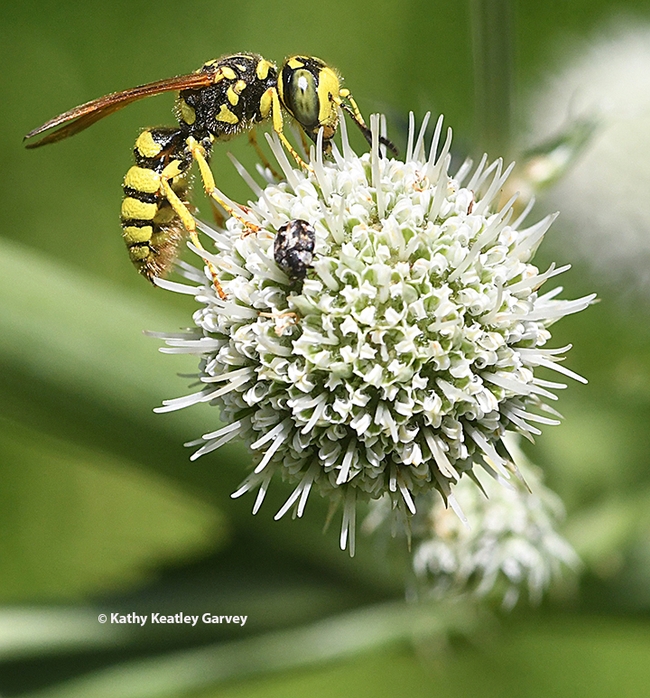
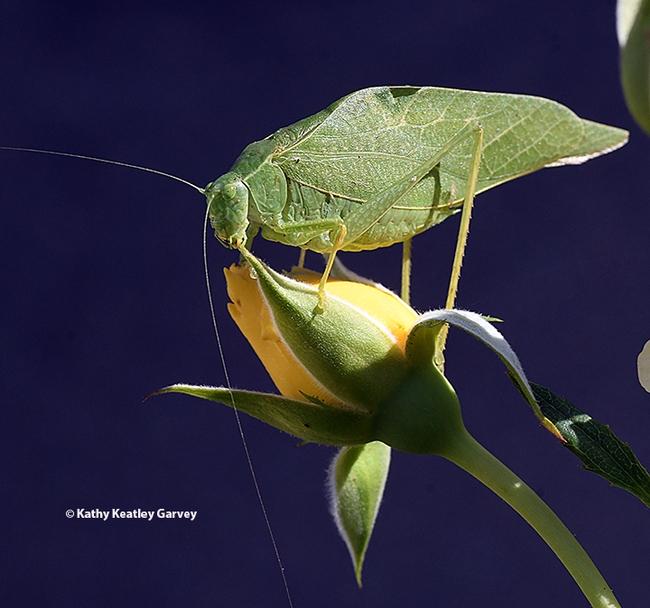
- Author: Kathy Keatley Garvey
It was a tough day for a Tettigoniid on a Tithonia.
When a katydid (Tettigoniid) encountered a crab spider on a Mexican sunflower, Tithonia rotundifola, in our garden, the katydid didn't last long. The spider administered a venomous bite and it was all over. The small, aggressive predator dragged its large prey beneath the Mexican sunflower to consume its meal. The cycle of life...
Do you know how katydids got their nickname?
The males have stridulating organs on their forewings and produce a shrill sound interpreted as “Katy-did, Katy-didn't."
Well, in this case the crab spider did (survive to live another day) and the katydid didn't.
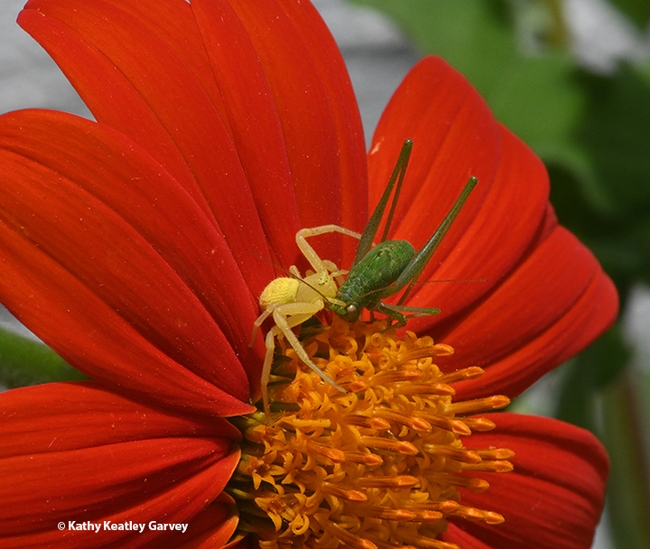
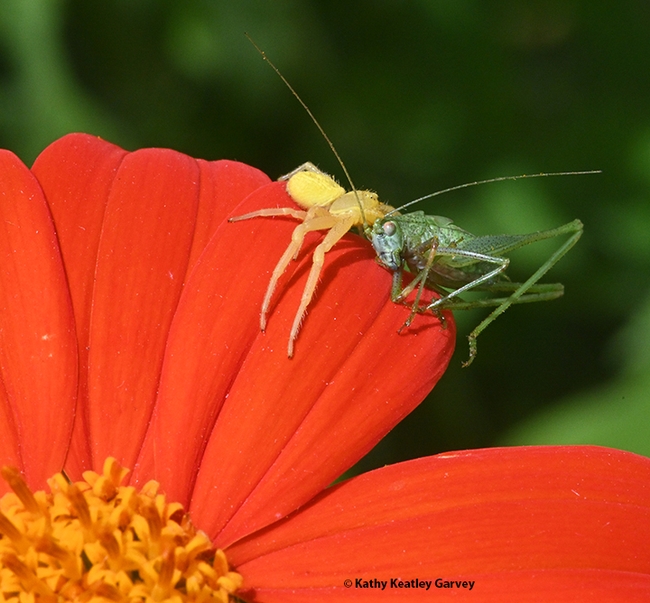
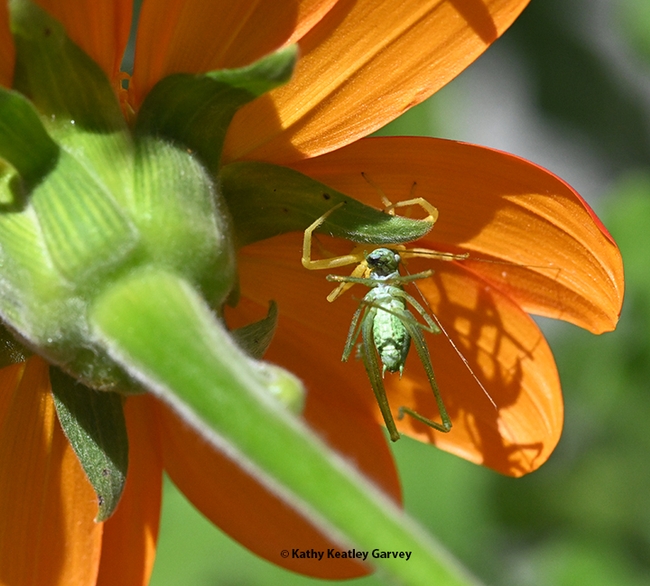
- Author: Kathy Keatley Garvey
It's not a question of whether katydid did or didn't.
She did.
In answer to what-are-we-going-to-see-next-in-insect-sightings-today-in-our-weird-climate-changing patterns, a katydid appeared on our yellow rose bush on Nov. 21 in Vacaville, Calif.
And stayed for several days.
Usually, they are difficult to see in green vegetation, what with their green bodies and detailed venation. It's not good camouflage to hang out on a yellow rose.
"Katydids resemble grasshoppers but have long antennae," according to the UC Statewide Integrated Pest Management Program (UC IPM) in its pest management website on Scudderia furcata. "Female katydids lay their gray, oval 1/8- to 1/4-inch long eggs in two overlapping rows on twigs and leaves or into the edges of their chewing damage. Nymphs appear in April and May and require 2 to 3 months to mature. Katydids produce one generation a year."
They do like fruit, including peach, nectarine, apricot, and pear. "Katydids may feed on leaves or fruit. Katydids do not eat the whole fruit. They often take a bite and move on, allowing the feeding site to become covered with grayish scar tissue and the expanding fruit to become misshapen. Most damage is done by nymphs."
Last summer we saw them feeding on our nectarines, and later we noticed them hanging out on our Mexican sunflower (Tithonia). Usually they're gone by October.
Not this katydid.
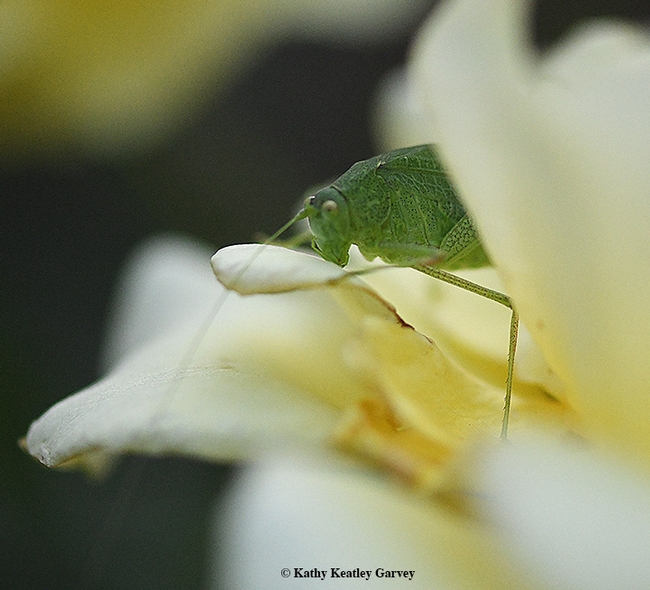
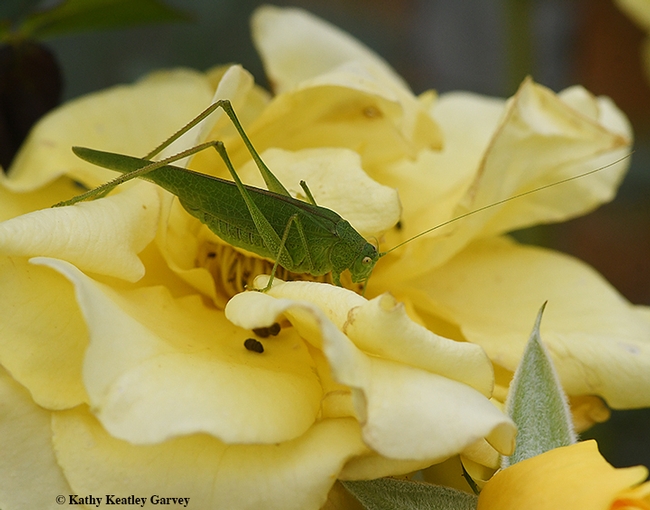
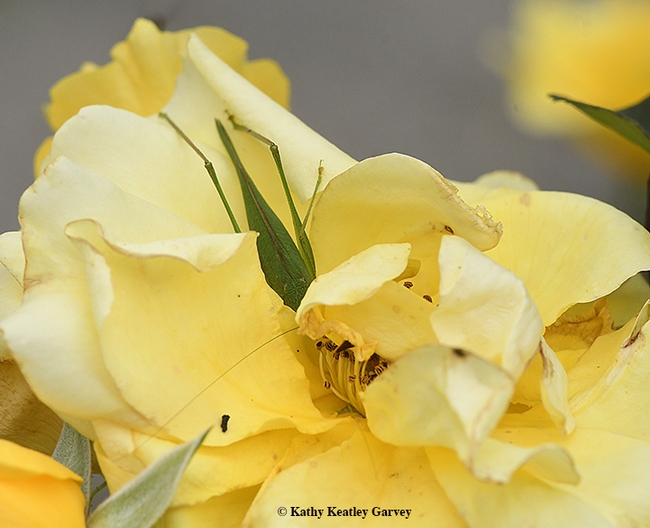
- Author: Kathy Keatley Garvey
I've always rather liked katydids.
Anyone who is called "Kate" or "Katy" in their childhood usually winds up with "Katydid" as a nickname. And they repeatedly hear "Katy did. Katy didn't" (the sound the insect makes).
So when a katydid appeared on our Mexican sunflower (Tithonia) this morning, yours truly (once a Kate and a Katydid) grabbed a camera.
Up close, they look like prehistoric animals, a mini version of the huge dinosaurs that roamed the earth 245 million years ago.
From the family Tettigoniidae and the order Orthoptera (grasshoppers, crickets and katydids), they're found throughout the world except in Antarctica. Sometimes katydids are called long-horned grasshoppers or bush crickets.
Fruit growers know the katydids as pests. They scar fruit such as citrus, taking a bite from one and moving onto the next. You can imagine what that does to the market value.
The UC Statewide Integrated Pest Management Program (UC IPM) provides information about the forktailed bush katydid: (Scudderia furcata) and the angularwinged katydid (Microcentrum retinerve) in its Citrus Pest Management Guidelines: "Of the two species feeding on citrus, only the forktailed katydid causes economic damage. This species feeds on young fruit at petal fall with subsequent buildup of scar tissue and distortion of expanding fruit. Katydids take a single bite from a fruit and then move to another feeding site on the same or nearby fruit. In this way, a few katydids can damage a large quantity of fruit in a short time. They also eat holes in leaves and maturing fruit, creating injury that resembles damage by citrus cutworm. The angularwinged katydid is less abundant than the forktailed katydid and feeds only on leaves."
Katydids also damage such fruits as pomegranates, pears, peaches, plums and apricots.
"Our" little katydid fed on the petals of the Tithonia, stopping occasionally to look at the photographer.
Katy did and then Katy didn't.
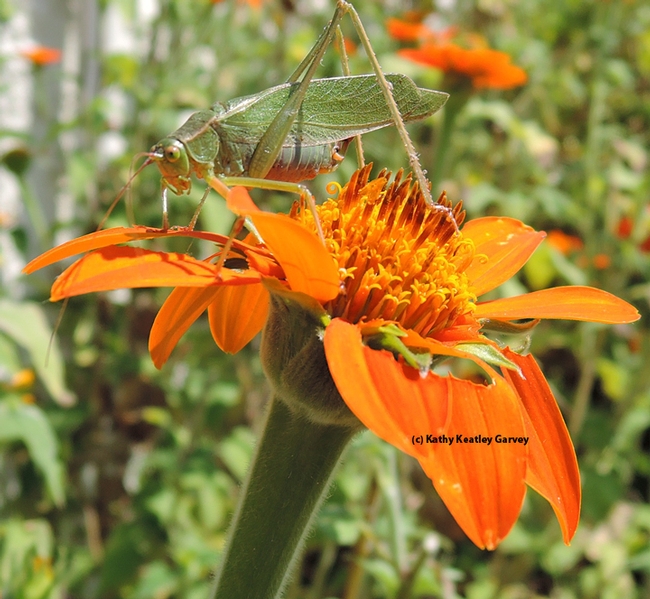
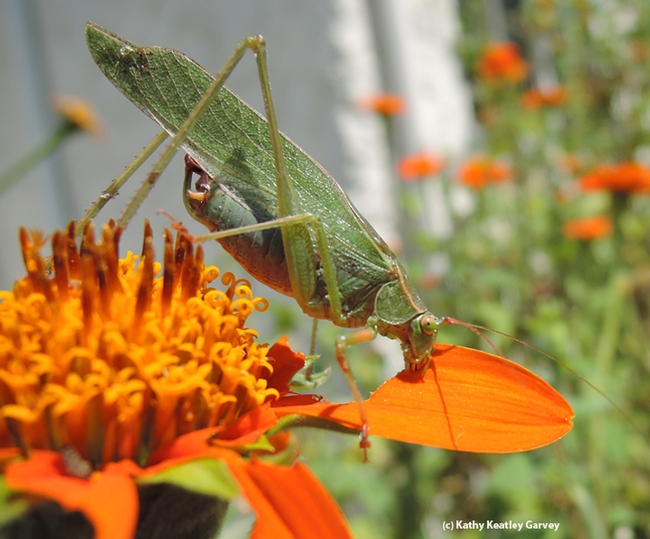
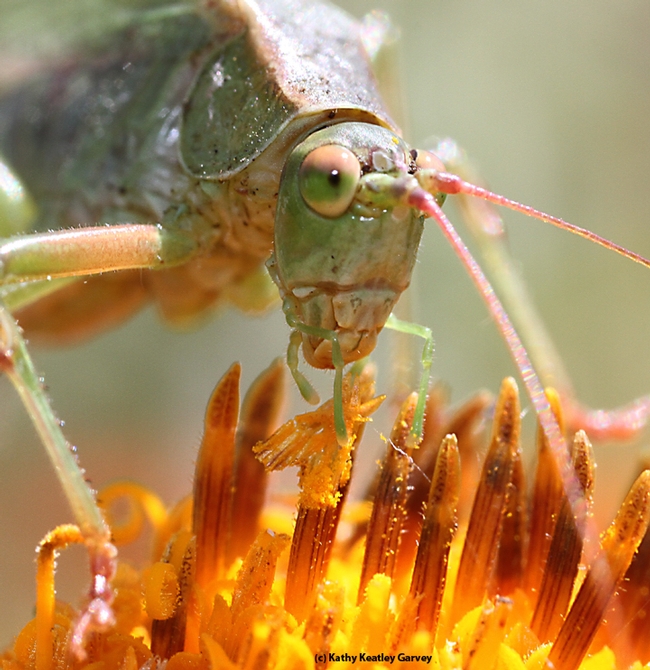
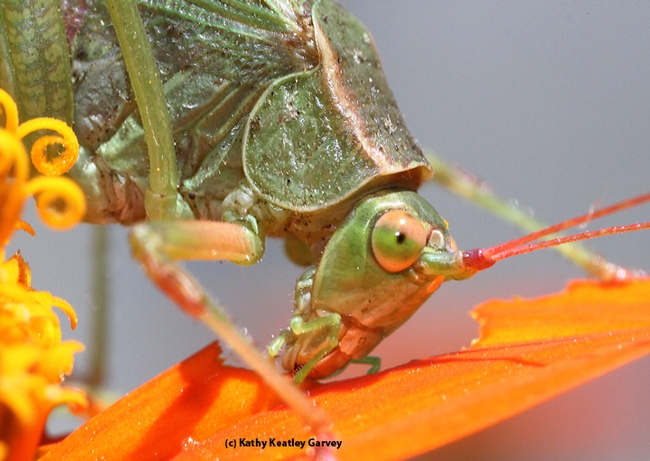
- Author: Kathy Keatley Garvey
What's that hopping on our patio?
At first we thought it was a grasshopper. Not!
It was a katydid, sometimes called a "long-horned grasshopper," from the family Tettigoniidae (as identified by Lynn Kimsey, director of the Bohart Museum of Entomology and UC Davis professor of entomology, and native pollinator specialist Robbin Thorp, emeritus professor of entomology at UC Davis).
"Katydids have long, threadlike antennae," said Kimsey. "Grasshopper antennae are rarely much longer than the head."
Said Thorp: "Note the long slender antennae (as long as or longer than the body); the very long slender jumping hind legs; and the scimitar-like ovipositor at the end of the abdomen."
Scientists tell us that the number of described species in the family Tettigoniidae exceeds 6400. Most katydids are green. They're often perfectly camouflaged in bushes and trees.
A katydid. The name is derived from the "song" it sings by rubbing its wings together. "Katy did." "Katy didn't."
This katydid, a female, responded to our footsteps. (Their "ears" or hearing organs are on their front feet.)
It hopped away, but not before we captured its image.
